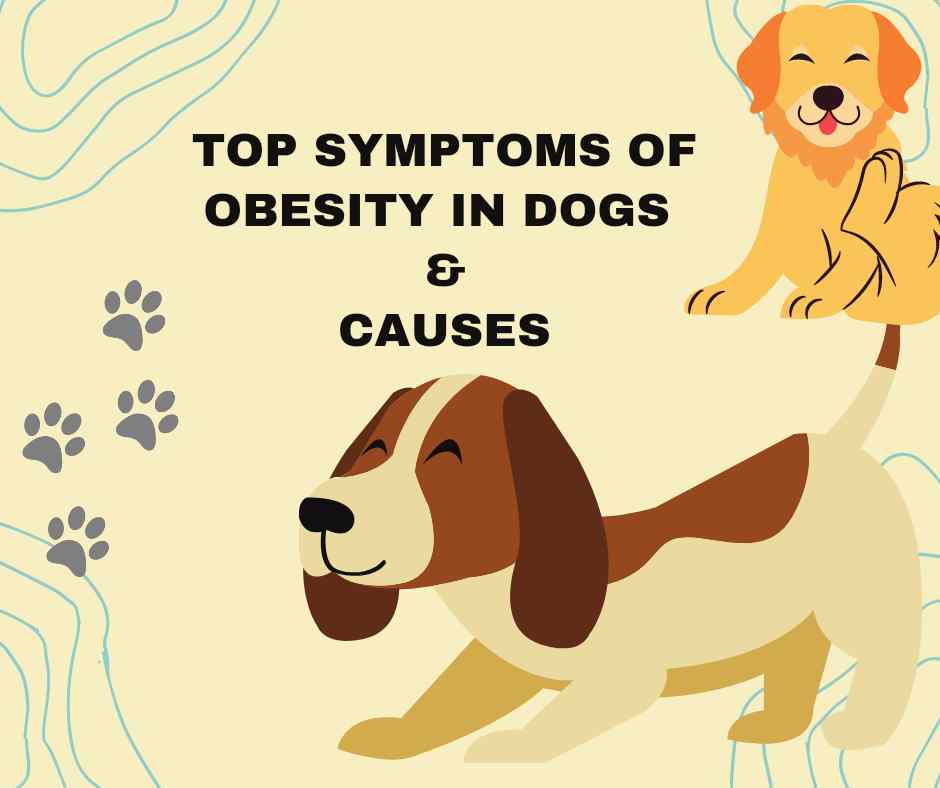10 Symptoms of Obesity in Dogs

Symptoms of obesity in dogs have been an issue for dog owners, and in this article, we will be discussing the causes, prevention, and symptoms of obesity in dogs.
So, let’s get started and make sure our loyal companions stay happy and healthy!
Symptoms Of Obesity In Dogs
Here are the most common symptoms of obesity in dogs which are as follows:
1. Excessive body fat
Dogs who are obese or overweight will have too much body fat, especially in the areas around their ribs, hips, and neck.
Heart disease, diabetes, and joint troubles are just a few of the health concerns that can result from this.
Also, it may affect their quality of life, making it challenging for children to play and engage in physical exercise.
2. Difficulty breathing
A dog’s respiratory system may experience strain from carrying additional weight, making it more challenging for them to breathe healthily.
Particularly when exercising, this may lead individuals to pant excessively or get out of breath.
It may also cause respiratory failure in extreme circumstances.
3. Reduced stamina
Overweight or obese dogs may fatigue more rapidly than their equivalents of normal weight.
They may find it challenging to play or engage in physical exercise for long periods of time as a result.
Moreover, they could lose interest in physical activity or play and instead choose to sleep.
4. Joint problems
A dog’s joints can experience severe pressure from carrying excess weight, especially the hips, knees, and ankles.
This might eventually result in disorders that can be painful and restrict movements, such as hip dysplasia or arthritis.
Dogs with joint issues could find it challenging to climb stairs, get up and down, or engage in physical activities.
5. Reduced mobility
Obesity dogs could have trouble getting up or up stairs, and they might hesitate to jump or run.
This may affect how they play and engage with their surroundings.
Also, it could make it uncomfortable for them and make it harder for them to move around freely.
6. Increased risk of disease
A number of illnesses, including diabetes, high blood pressure, heart disease, and several kinds of cancer, are more likely to occur in overweight or obese dogs.
These diseases may need long-term medical care since they may affect their general health and quality of life.
7. Digestive issues
Dogs that are obese may also experience digestive problems such as constipation, diarrhea, and bloating.
This may be uncomfortable and call for medical attention.
Dogs with digestive problems may experience vomiting or other gastrointestinal symptoms, as well as changes in appetite.
8. Changes in behavior
In addition to becoming more irritable or sluggish, some fat dogs may also become more nervous or sad.
This may have an effect on their way of life and their capacity to communicate with their human relatives.
Also, it could be more challenging for children to play or engage in physical exercise, which might start a vicious cycle of inactivity and weight gain.
9. Increased risk of injury
A dog is more likely to get injuries from falls or other mishaps when carrying excess weight since it puts more strain on its muscles and joints.
This may necessitate medical intervention and affect their capacity for play and physical exercise.
In extreme circumstances, it may potentially result in paralysis or lifelong impairment.
10. Increased thirst and urination
Due to the additional stress on their organs, dogs who are overweight may need to consume more water than normal. Moreover, this may cause more urine.
Due to increased water consumption, dogs who are overweight or obese may need to urinate more frequently.
Causes of Obesity In Dogs
The following are some common causes of obesity in dogs:
- Overeating: Feeding dogs more calories than they need on a daily basis is one of the most common causes of obesity in dogs. This can happen if the owner feeds their dog table scraps, or if they give them treats too frequently.
- Lack of exercise: Dogs need regular exercise to burn off calories and maintain a healthy weight. Without enough exercise, dogs can easily become overweight.
- Age: As dogs age, their metabolism slows down and they may not need as many calories as they did when they were younger. Owners may need to adjust their dog’s diet to reflect this change.
- Breed: Some dog breeds are more prone to obesity than others. Breeds that are known to be more prone to obesity include Labrador Retrievers, Basset Hounds, and Beagles, among others.
- Genetics: Just like humans, some dogs may have a genetic predisposition to obesity. Dogs with certain genes may have a slower metabolism or have a harder time feeling full, which can contribute to obesity.
- Medical conditions: Certain medical conditions, such as hypothyroidism, can contribute to weight gain in dogs. It’s important for owners to take their dogs to the vet for regular check-ups to monitor their dog’s health.
- Medications: Some medications, such as steroids, can cause weight gain in dogs. Owners should speak to their vet about the potential side effects of any medication their dog is taking.
- Neutering: Spaying or neutering can cause a dog’s metabolism to slow down, which can contribute to weight gain if their calorie intake is not reduced accordingly.
- Stress: Dogs that are under stress may overeat as a way to cope. This can happen if the dog is left alone for long periods of time, or if there are changes in the household that cause stress for the dog.
Effects of Obesity On Dogs
Obesity can have various negative effects on dogs. Here are some possible effects of obesity in dogs:
- Increased risk of joint problems: Obesity can place additional stress on the joints, leading to problems such as osteoarthritis. This can result in pain, inflammation, and reduced mobility, thus affecting the dog’s overall quality of life.
- Increased risk of heart disease: Obesity can put a strain on the heart, leading to conditions such as hypertension, heart failure, and arrhythmias. These can result in fatigue, shortness of breath, and poor exercise capacity in dogs.
- Increased risk of respiratory problems: Obese dogs may have trouble breathing due to increased weight around the chest and abdomen. This can lead to conditions such as exercise intolerance and sleep apnea.
- Increased risk of diabetes: Obesity can interfere with the body’s ability to regulate blood sugar levels, resulting in insulin resistance and the development of diabetes.
- Increased risk of liver disease: Obesity can cause fat to accumulate in the liver, leading to conditions such as hepatitis and cirrhosis.
- Increased risk of urinary tract problems: Obese dogs may be more prone to urinary tract infections, bladder stones, and incontinence.
- Increased risk of skin problems: Obesity can cause skin folds around the neck and tail, which can become a breeding ground for bacterial and fungal infections.
- Increased risk of cancer: Obesity has been linked to an increased risk of several types of cancer in dogs, such as mammary gland tumors, lymphoma, and bladder cancer.
- Reduced lifespan: Obesity can shorten a dog’s lifespan by as much as two years, according to some studies.
Learn more about the benefits of proper nutrition in dogs.
Tips To Prevent Obesity In Your Dog
To prevent obesity in your dog, the following are some tips can be useful:
- Appropriate Portion Size: It’s crucial to provide your dog with a balanced and healthy diet that is suitable for its age, breed, and physical activity. Overfeeding can quickly lead to weight gain, making it important to control portion sizes. You can seek guidance from a veterinarian to determine the appropriate diet for your dog.
- Avoid Table Scraps: Human food is not suitable for dogs, so avoid feeding it regularly. Table scraps are often high in calories and fat, which can lead to weight gain and other health issues.
- Exercise and Physical Activity: A sedentary lifestyle can contribute to weight gain in dogs. Regular exercise and physical activity can help your dog to maintain a healthy body weight. It is up to you to offer them an appropriate level of activity, depending on their age and breed.
- Regular Health Check-ups: Visit your veterinarian regularly to assess your dog’s body condition score and overall physical health. Regular check-ups can help detect health issues early and prevent them from escalating.
- Provide Treats in Moderation: Treats and snacks are an essential part of training and rewarding, but be careful. Avoid overfeeding your dog with treats as they can add to the daily calorie intake leading to weight gain. Provide these in moderation.
- Avoid Free-feeding: Free-feeding is a practice that can lead to obesity. It’s best to stick to fixed feeding schedules to control the portion size and calorie intake of your dog.
- Choose Healthy Snacks: Treat your dog occasionally with healthy snacks like carrots, apples, bananas, and green beans instead of high-fat treats like cheese, sausages, or processed meats.
- Feed High-Quality Pet Food: Feeding your dog with high-quality pet food can aid in weight loss and overall health. Look for dog food labels that indicate high protein and low carbohydrate content, as protein can help with weight loss.
- Keep The Dog’s Water Bowl Full: Staying hydrated is essential for maintaining a healthy dog. Keeping your dog’s water bowl full can help minimize overeating; sometimes, dogs drink instead of eating.
Top Breeds of Dogs Affected By Obesity
Here are some dog breeds that are most prone to obesity:
- Pugs
- Beagles
- Golden Retrievers
- English Springer Spaniels
- Border Terriers
- Cocker Spaniels
- Dachshunds
- English Bulldogs
- Labrador Retrievers
Learn more about the meaning of your dog sleeping all day.
Related questions
What are the common symptoms of obesity in dogs?
Some common symptoms of obesity in dogs include excessive weight gain, decreased mobility, difficulty breathing, and lethargy.
Is there a way to tell if my dog is at a healthy weight?
Yes, you can tell if your dog is at a healthy weight by checking their body condition score, which assesses its overall body fat percentage.
Learn more about the signs of a dog in pain.
How can I help my overweight dog lose weight?
To help your dog lose weight, you can take them for walks more often, reduce their portion sizes, and make sure they are eating a balanced diet.
Are certain dog breeds more prone to obesity?
Yes, some dog breeds are more prone to obesity such as Labrador Retrievers, Pugs, and Beagles.
Learn more about dogs coughing and not eating.
Can obesity in dogs lead to serious health issues?
Yes, obesity in dogs can lead to serious health issues including diabetes, heart disease, and joint problems.
How often should I bring my dog to the vet to monitor their weight?
You should bring your dog to the vet at least once a year to monitor their weight and overall health.
Learn more about dogs drinking a lot and not eating.
Conclusion
In conclusion, recognizing the symptoms of obesity in dogs is crucial for their health and well-being.
By keeping an eye out for signs such as excessive weight gain, difficulty breathing, and decreased energy levels, you can take proactive steps to prevent and manage this condition.
With proper diet, exercise, and veterinary care, you can help your furry friend live a long and happy life.
Remember, a healthy dog is a happy dog! Learn more about dogs sneezing excessively.




![Dog Not Eating But Throwing Up [9 Reasons & Tips] Dog Not Eating But Throwing Up](https://petcreeks.com/wp-content/uploads/2023/04/Dog-Not-Eating-But-Throwing-Up-768x555.jpg)

![Eye Trauma in Dogs [Signs, Causes & More] Eye Trauma in Dogs](https://petcreeks.com/wp-content/uploads/2023/10/pexels-cynthia-vh-1572849.jpg)